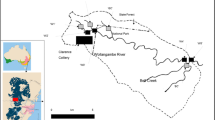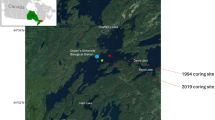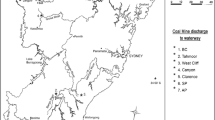Abstract
Mining is one of the key industries in the world and mine water pollution is a serious threat to aquatic ecosystems. Historical monitoring data on the pollution history and impacts in aquatic ecosystems, however, are rarely available, so paleolimnological methods are required to explore the consequences of past pollution. We studied the history of cladoceran community dynamics in Lake Kirkkojärvi, southern Finland, including the periods before, during and after mining. We analyzed the geochemical composition and cladoceran subfossil remains in a 210Pb-dated sediment core to evaluate the magnitude, rate, and direction of cladoceran community changes through time. The cladoceran community was altered significantly by mining activity that occurred during the mid-twentieth century. During more recent times, however, eutrophication effects have overridden the impacts of mining. After mining ceased, the cladoceran community underwent an abrupt regime shift towards taxa that reflect more eutrophic conditions. This change was caused by intensive farming activity and fertilizer use over the past few decades. The recent history of Lake Kirkkojärvi is a textbook example of a regime shift triggered by multiple human-caused stressors. Our findings also highlight the utility of cladocerans as bio-indicators in pollution research and illustrate the sensitivity of aquatic ecosystems to anthropogenic modification.




Similar content being viewed by others
References
Ahlgren G, Lundstedt L, Brett M, Forsberg C (1990) Lipid composition and food quality of some freshwater phytoplankton for cladoceran zooplankters. J Plankton Res 12:809–818
Alexander D (1986) Northern Italian dam failure and mudflow. Disasters 10:3–7
Anderson NJ, Renberg I, Segerström U (1995) Diatom production responses to the development of early agriculture in a boreal forest lake-catchment (Kassjon, northern Sweden). J Ecol 83:809–822
Appleby PG (2001) Chronostratigraphic techniques in recent sediments. In: Last WM, Smol JP (eds) Tracking environmental change using lake sediments. Volume 1: basin analysis, coring, and chronological techniques. Kluwer Academic Publishers, Dordrecht, pp 171–203
Appleby PG, Nolan PJ, Gifford DW, Godfrey MJ, Oldefield F, Anderson NJ, Battarbee RW (1986) 210Pb dating by low background gamma counting. Hydrobiologia 141:21–27
Appleby PG, Richardson N, Nolan PJ (1991) 241Am dating of lake sediments. Hydrobiologia 214:35–42
Appleby PG, Richardson N, Nolan PJ (1992) Self-absorption corrections for well-type germanium detectors. Nucl Instrum Meth B 71:228–233
Arruda JA, Marzolf GR, Faulk RT (1983) The role of suspended sediments in the nutrition of zooplankton in turbid reservoirs. Ecology 64:1225–1235
Belyaeva M, Deneke R (2007) Colonization of acidic mining lakes: chydorus sphaericus and other Cladocera within a dynamic horizontal pH gradient (pH 3-7) in Lake Senftenberger See (Germany). Hydrobiologia 594:97–108
Bennett K (1996) Determination of the number of zones in a biostratigraphical sequence. New Phytol 132:155–170
Bilotta GS, Brazier RE (2008) Understanding the influence of suspended solids on water quality and aquatic biota. Water Res 42:2849–2861
Birks HJB, Gordon AD (1985) Numerical methods in Quaternary pollen analysis. Academic Press, London
Birks HJB, Line JM (1992) The use of rarefaction analysis for estimating palynological richness from Quaternary pollen-analytical data. Holocene 2:1–10
Bjerring R, Becares E, Declerck S, Gross EM, Hansson L-A, Kairesalo T, Nykänen M, Halkiewicz A, Kornijów R, Conde-Porcuna JM, Seferilis M, Noges T, Moss B, Amsinck SL, Van Odgaard B, Jeppesen E (2009) Subfossil Cladocera in relation to contemporary environmental variables in 54 Pan-European lakes. Freshw Biol 54:2401–2417
Bossuyt BTA, Jansen CR (2005) Copper toxicity to different field- collected cladoceran species: intra- and interspecies sensitivity. Environ Pollut 136:145–154
Boucherle MM, Züllig H (1983) Cladoceran remains as evidence of change in the trophic state in three Swiss lakes. Hydrobiologia 103:141–146
Boudreau BP, Barry M, L’Esperance C, Algar CK, Johnson BD (2013) The mechanics of soft cohesive sediments during early diagenesis. In: Reible DD (ed) Processes, assessment and remedation of contaminated sediments. Springer, New York, pp 81–105
Bozelli RL (1996) The influence of bauxite tailings on the cladoceran populations of Lake Batata, Amazonia, Brazil. Int Rev Hydrobiol 81:621–634
Bradbury JP, Megarad RO (1972) Stratigraphic record of pollution in Shagawa Lake, Northeastern Minnesota. Geol Soc Am Bull 83:2639–2648
Brix KV, DeForest DK, Adams WJ (2001) Assessing acute and chronic copper risks to freshwater aquatic life using species sensitivity distributions for different taxonomic groups. Environ Toxicol Chem 20:1846–1856
Brooks JL, Dodson SI (1965) Predation, body size and composition of plankton. Science 150:28–35
Calonius AE (1805) A117:3/1-14. Inkula: Isojaon kartta ja jakoraja. [Map]. Available at Digital Archieves of National Archives of Finland. http://digi.narc.fi/digi/slistaus.ka?ay=246311. Accessed 14 June 2017
Ciszewski D, Aleksander-Kwaterczak U, Pociecha A, Szarek-Gwiazda E, Waloszek A, Wilk-Woźniak E (2013) Small effects of a large sediment contamination with heavy metals on aquatic organisms in the vicinity of an abandoned lead and zinc mine. Environ Monit Assess 185:9825–9842
Coard MA, Cousen SM, Cuttler AH, Dean HJ, Dearing JA, Eglinton TI, Greaves AM, Lacey KP, O’Sullivan PE, Pickering DA, Rhead MM, Rodwell JK, Simola H (1983) Paleolimnological studies of annually-laminated sediments in Loe Pool, Cornwall, U.K. Hydrobiologia 103:185–191
Couillard Y, Courcelles M, Cattaneo A, Wunsam S (2004) A test of the integrity of metal records in sediment cores based on the documented history of metal contamination in Lac Dufault (Québec, Canada). J Paleolimnol 32:149–162
Doig LE, Schiffer ST, Liber K (2015) Reconstructing the ecological impacts of eight decades of mining, metallurgical, and municipal activities on a small boreal lake in Northern Canada. Integr Environ Assess Manag 11:490–501
Downing AL, Leibold MA (2010) Species richness facilitates ecosystem resilience in aquatic food webs. Freshw Biol 55:2123–2137
Downing AL, Brown BL, Leibold MA (2014) Multiple diversity-stability mechanisms enhance population and community stability in aquatic food webs. Ecology 95:173–184
Dupuis LV, Hann BJ, Paterson M (2015) Littoral cladoceran community reassembly following the cessation of disturbance. J Paleolimnol 54:121–135
EIFAC (1965) Water quality criteria for European freshwater fish. Report on finely divided solids and inland fisheries. EIFAC technical paper no. 1. Int J Air Water Poll 9:151–168
Escobar H (2015) Mud tsunami wreaks ecological havoc in Brazil. Science 350:1138–1139
European Environment Agency (2010) Freshwater—state and impacts (Finland). European Environment Agency. https://www.eea.europa.eu/soer/countries/fi/freshwater-state-and-impacts-finland-1. Accessed 5 June 2017
Feasby DG, Chambers DB, Fernandez Rubio R, Gascó Montes JM, Hynes TP (1999) Environmental Impact and Reclamation Planning following the April 25, 1998 accidental Tailings Release at the Boliden Apirsa Mine at Aznalcóllar, Spain. In: Fernández RR (ed) Mine, water & environment I. International Mine Water Association International Congress; 1999 Sevilla, Spain. International Mine Water Association, pp 279–290
Fields S (2003) The earth’s open wounds: abandoned and orphaned mines. Environ Health Perspect 111:154–161
Finnish Meteorological Institute (2015) Vuositilastot. http://ilmatieteenlaitos.fi/vuositilastot. Accessed 1 June 2016
Folke C, Carpenter S, Walker B, Scheffer M, Elmqvist T, Gunderson L, Holling CS (2004) Regime shifts, resilience, and biodiversity in ecosystem management. Annu Rev Ecol Evol Syst 35:557–581
Frisch D, Cottenie K, Badosa A, Green A (2012) Strong spatial influence on colonization rates in a pioneer zooplankton metacommunity. PLoS ONE 7(7):e40205. https://doi.org/10.1371/journal.pone.0040205
Garrido AV, Bozelli RL, Esteves FDA, Alves LS (2003) Long-term patterns of the planktonic cladoceran community of Batata Lake, Amazonia, Brazil. Acta Limnol Bras 15:41–53
Hammer Ø, Harper DAT, Ryan PD (2001) PAST: paleontological statistics software package for education and data analysis. Palaeontologia Electronica 4(1):9
Hoffman W (1987) Cladocera in space and time: analysis of lake sediments. Hydrobiologia 145:315–321
Holopainen IJ, Holopainen A-L, Huitu E, Rahkola-Sorsa M, Zingel P (2008) The pelagic food web in forest lakes affected by alkaline mining waste in NW Russia. Est J Ecol 57:214–228
Ilus E, Saxén R (2005) Accumulation of Chernobyl-derived 137Cs in bottom sediments of some Finnish lakes. J Environ Radioact 82:199–221
Ilus E, Puhakainen M, Saxén R (1993) Gamma-emitting radionuclides in the bottom sediments of some Finnish lakes. STUK-A112. Finnish Centre for Radiation and Nuclear Safety, Helsinki
Jeppesen E, Leavitt P, De Meester L, Jensen JP (2001) Functional ecology and palaeolimnology: using cladoceran remains to reconstruct anthropogenic impact. Trends Ecol Evol 16:191–198
Johnson DB (2002) Chemical and microbiological characteristics of mineral spoils and drainage waters at abandoned coal and metal mines. Water Air Soil Poll 3:47–66
Kaskimies SJ, Sinisalo H (1973) Viljakkala – pitäjä Pirkanmaalla. Viljakkalan kunta, Ylöjärvi
Kelly MG (1988) Mining and the freshwater environment. Elsevier Applied Science, London
Kerfoot WC, Robbins JA, Weider LJ (1999) A new approach to historical reconstruction: combining descriptive and experimental paleolimnology. Limnol Oceanogr 44:1232–1247
Keskitalo P (2014) Ylöjärven ympäristön tila 2013. Maankäyttö ja ympäristö. Ylöjärven kaupunki, Ylöjärvi
Kihlman S, Kauppila T (2010) Tracking the aquatic impacts of historical metal mine using lacustrine protists and diatom algae. Mine Water Environ 29:116–134
Kirk KL (1992) Effects of suspended clay on Daphnia body growth and fitness. Freshw Biol 28:103–109
Koivisto S, Ketola M, Walls M (1992) Comparison of five cladoceran species in short- and long-term copper exposure. Hydrobiologia 248:125–136
Korhola A, Rautio M (2001) Cladocera and other Branchiopod crustaceans. In: Last WM, Smol JP (eds) Tracking environmental change using lake sediments, vol 4. Zoological indicators. Kluwer Academic Publishers, Dordrecht, pp 5–41
Korhola A, Olander H, Blom T (2000) Cladoceran and chironomid assemblages as qualitative indicators of water depth in subarctic Fennoscandian lakes. J Paleolimnol 24:43–54
Kurek J, Korosi JB, Jeziorski A, Smol JP (2010) Establishing reliable minimum count sizes for cladoceran subfossils sampled from lake sediments. J Paleolimnol 44:603–612
Leppänen JJ, Weckström J, Korhola A (2017) Paleolimnological fingerprinting of the impact of acid mine drainage after 50 years of chronic pollution in a southern Finnish lake. Water Air Soil Poll. https://doi.org/10.1007/s11270-017-3417-2
Lotter AF, Juggins S (1991) PLOPROF, TRAN and ZONE. Programs for plotting, editing and zoning of pollen and diatom data. INQUA Commmission for the study of the Holocene, Working Group on Data Handling Methods, Newsletter 6
Louette G, de Meester L (2005) High dispersal capacity of cladoceran zooplankton in newly founded communities. Ecology 86:353–359
Manoylov KM, Ognjanova-Rumenova N, Stevenson RJ (2009) Morphotype variations in subfossil diatom species of Aulacoseira in 24 Michigan Lakes, USA. Acta Bot Croat 68:401–419
McDonald CP, Urban NR (2007) Sediment radioisotope dating across a stratigraphic discontinuity in a mining-impacted lake. J Environ Radioact 92:80–95
Nevalainen L, Luoto TP (2013) Limnological deterioration forces community and phenotypic changes in Cladocera: tracking eutrophication of Mallusjärvi, a lake in southern Finland. Boreal Environ Res 18:209–222
Nevalainen L, Sarmaja-Korjonen K, Luoto TP (2011) Sedimentary cladocera as indicators of past water-level changes in shallow northern lakes. Quat Res 75:430–437
Nevalainen L, Luoto TP, Kultti S, Sarmaja-Korjonen K (2013) Spatio-temporal distribution of sedimentary Cladocera (Crustacea: Branchiopoda) in relation to climate. J Biogeogr 40:1548–1559
Nykänen M, Liukkonen M, Kairesalo T (2006) Changes of predation pressure by fish in Lake Vesijärvi reflected by sedimentary cladoceran remains. Verhandlungen Internationale Vereinigung für theoretische und angewandte Limnologie 29:1321–1326
Outridge PM, Wang F (2016) The stability of metal profiles in freshwater and marine sediments. In: Blais JM, Rosen MR, Smol JP (eds) Environmental contaminants using natural archives to track sources and long-term trends of pollution. Springer, Dordrecht, pp 35–60
Parviainen A (2009) Tailings mineralogy and geochemistry at the abandoned Haveri Au–Cu Mine, SW Finland. Mine Water Environ 28:291–304
Parviainen A, Kauppila T, Loukola-Ruskeeniemi K (2012) Long-term lake sediment records and factors affecting the evolution of metal(loid) drainage from two mine sites (SW Finland). J Geochem Explor 114:46–56
Pitkänen M-L (2007) Alholahden alueen Natura 2000 –alueen hoito- ja käyttösuunnitelma. Pirkanmaan ympäristökeskuksen raportteja 4/2007. Pirkanmaan ympäristökeskus, Tampere
Pöyry (2015) Haverin entisen kaivoksen jätealueen kunnostuksen jatkosuunnitelma ja alustava kustannusarvio. Pirkanmaan ELY –keskus ja Ylöjärven Kaupunki, Ylöjärvi
Randsalu-Wendrup L, Conley DJ, Carstensen J, Fritz SC (2016) Paleolimnlogical records of regime shifts in lakes in response to climate change and anthropogenic activities. J Paleolimnol 56:1–14
Räsänen J, Kauppila T, Salonen V-P (2006) Sediment-based investigation of naturally or historically eutrophic lakes—implications for lake management. J Environ Manag 79:253–265
Sarma SSS, Nandini S (2006) Review of recent ecotoxicological studies on cladocerans. J Environ Sci Health B 41:1417–1430
Saros JE, Michel TJ, Interlandi SJ, Wolfe AP (2005) Resource requirements of Asterionella formosa and Fragilaria crotonensis in oligotrophic alpine lakes: implications for recent phytoplankton community reorganizations. Can J Fish Aquat Sci 62:1681
Sienkiewicz E, Gasiorowski M (2016) The evolution of a mining lake—from acidity to neutralization. Sci Total Environ 557–558:343–354
Soldán P, Pavonič M, Bouček J, Kokeš J (2001) Baia Mare accident—brief ecotoxicological report of Czech experts. Ecotox Environ Saf 49:255–261
Stankovic I, Ternjej I, Mihaljevic Z, Furac L, Kerovec M (2011) Crustacean plankton community (Crustacea: Copepoda and Cladocera) in gypsum karst lakes and their relation to abiotic parameters. Hydrobiologia 666:145–153
Stenson JAE (1976) Significance of predator influences on composition of Bosmina spp. populations. Limnol Oceanogr 21:814–822
Sterner RW (2009) Role of zooplankton in aquatic ecosystems. In: Likens GE (ed) Encyclopedia of inland waters. Academic Press, Oxford, pp 678–688
Suhett AL, Santangelo JM, Bozelli RL, Steinberg CEW, Farjalla VF (2015) An overview of the contribution of studies with cladocerans to environmental stress research. Acta Limnol Bras 27:145–159
Szeroczyñska K, Sarmaja-Korjonen K (2007) Atlas of subfossil cladocera from central and northern Europe. Friends of Lower Vistula Society, Poland
Thienpont JR, Korosi JB, Hargan KE, Williams T, Eickmeyer DC, Kimpe LE, Palmer MJ, Smol JP, Blais JM (2016) Multi-trophic level response to extreme metal contamination from gold mining in a subarctic lake. Proc R Soc Biol Sci Ser B. https://doi.org/10.1098/rspb.2016.1125
Valois AE, Keller WB, Ramcharan CW (2011) Recovery in a multiple stressor environment: using the reference condition approach to examine zooplankton community change along opposing gradients. J Plankton Res 33:1417–1429
Vandysh OI (2004) Zooplankton as an indicator of the state of lake ecosystems polluted with mining wastewater in the Kola Peninsula. Russ J Ecol 35:134–140
Vänni O (1928) Satakunta, Kotiseutututkimuksia III. Satakuntalainen Osuuskunta, Vammala
Von Der Ohe PC, Liess M (2004) Relative sensitivity distribution of aquatic invertebrates to organic and metal compounds. Environ Toxicol 23:150–156
Walseng B, Hessen DO, Halvorsen G, Schartau AK (2006) Major contribution from littoral crustaceans to zooplankton species richness in lakes. Limnol Oceanogr 51:2600–2606
Winegardner AK, Salter N, Aebischer S, Pienitz R, Derry AM, Wing B, Beisner BE, Gregory-Eaves I (2017) Cladoceran diversity dynamics in lakes from a northern mining region: responses to multiple stressors characterized by alpha and beta diversity. Can J Fish Aquat Sci. https://doi.org/10.1139/cjfas-2016-0449
Zawisza E, Szeroczyñska K (2007) The development history of Wigry Lake as shown by subfossil cladoceran. Geochronometria 27:67–74
Acknowledgements
This work was funded partly by the Tellervo and Juuso Walden Foundation and the K.H. Renlund Foundation. The authors are grateful to the Schulte-Tigges family and to Mr. Hannu Uotila for their invaluable comments. The authors thank Annika Parviainen and Tommi Kauppila for additional data and two anonymous reviewers for their comments, which greatly improved this manuscript.
Author information
Authors and Affiliations
Corresponding author
Electronic supplementary material
Below is the link to the electronic supplementary material.
Rights and permissions
About this article
Cite this article
Leppänen, J., Weckström, J. & Korhola, A. Mining pollution triggered a regime shift in the cladoceran community of Lake Kirkkojärvi, southern Finland. J Paleolimnol 60, 413–425 (2018). https://doi.org/10.1007/s10933-018-0030-3
Received:
Accepted:
Published:
Issue Date:
DOI: https://doi.org/10.1007/s10933-018-0030-3




